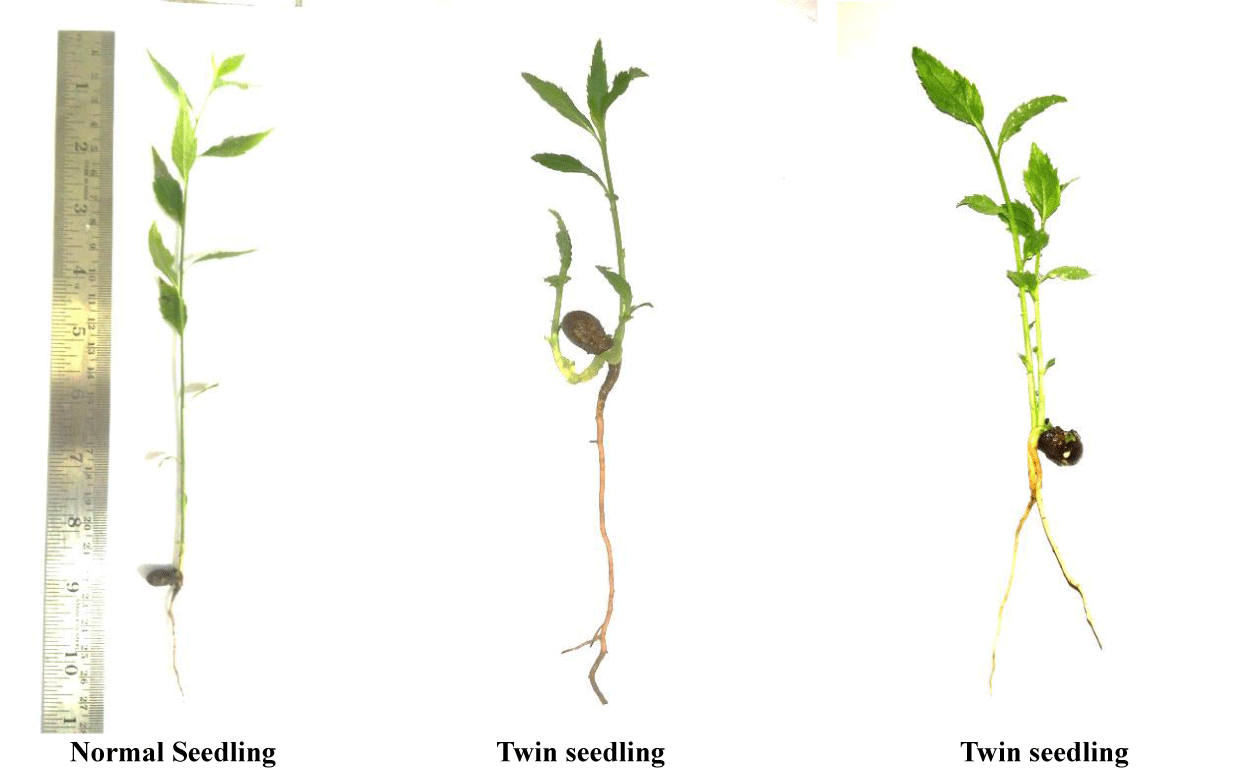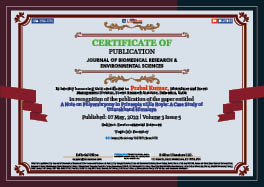Environmental Sciences . 2022 May 07;3(5):509-511. doi: 10.37871/jbres1472.
A Note on Polyembryony in Prinsepia utilis Royle: A Case Study of Uttarakhand Himalaya
Prabal Kumar1*, Devendra Kumar2 and Sanjay Singh3
2Biodiversity and Climate Change Division, Indian Council of Forestry Research and Education, Dehradun, India
3Division of Forestry Statistics, Indian Council of Forestry Research and Education, Dehradun, India
Bhekal, bhekali, bekoi is the vernacular term given to a moderate-sized underutilized deciduous shrub known as Prinsepia utilis Royle, widely distributed in the Himalayas at 1000-3000 msl., occurring frequently in open, sunny, dry places, rocky talus slopes, roadsides and in degraded hills. The genus belongs to Family Rosaceae comprising four species all over the world, among only P. utilis occur in India. The plant is reported to colonise the degraded areas in Garhwal Himalayas [1]. Therefore, the species could be useful for land reclamation in the Himalayas [2]. The plant is valued by local people for its edible oil yielding seed kernel [3]. Leaves are a very good source of fodder [4]. Species bloom in January till March while fruit ripe in April to June. Fruit are single-seeded, berry, oblong having fleshy edible mesocarp. The population of this valuable multipurpose species is declining rapidly due to anthropogenic pressure and habitat loss [5]. Therefore, there is a strong need to develop strategies for conservation on a priority basis. Development of nursery technique is a basic tool to raise plants with desired traits, within the stipulated period and fulfil the aims to enhance the desired population and species conservation. For the standardization and development of nursery technique and to determine the effect of depth and orientation of seed on germination behaviour of P. utils fully ripe fruits were collected from Chakrata forest division, Uttarakhand (30°41’32.69” N,77° 52’ 19.39” E) during April-May. Pulp was removed immediately after collection of fruit to avoid the fermentation and processed seeds were dried in a shady place. Germination studies were conducted at Nursery of Forest Tree Seed Laboratory, FRI, Dehradun.
The seeds were sown in bed prepared with the mixture of soil, sand, and FYM, in 1:1:1 ratio. The seeds were raised during June 2017. The germination of seeds commenced from 6 to 10 days after sowing. Growth performance was recorded up to 21 days after germination at the nursery (Table 1). While studying germination in the seeds of P. utilis, the author observed polyembryony.
| Table 1: Growth of abnormal seedling in P. utilis Royle. | |||
| S. No. | Shoot Height (cm) | Root Length (cm) | Remark |
| 1. | 5.8, 3.5 | 6.7 | One root with the conjoined shoot |
| 2. | 9.5, 6.8 | 6.4, 5.5 | Conjoined twin seedlings with two shoots and two roots. Growth normal |
| Normal Seedling | |||
| 1. | 20 | 6.0 | One root and one shoot |
Out of 1200 sown seeds, 875 seeds germinated (72.91 % germination) only 2 seedlings (0.22%) gave twin seedlings in nursery condition and the rest of the seed produced normal seedlings. These seedlings were marked for further study and comparison with the normal seedling. These twin seedlings showed retarded growth as compared to normal seedling at the day of completion of the test (Figure 1).
Polyembryony is a phenomenon of occurrence of more than one embryo in a seed resulting in the development of more than one seedling from it [6-11]. Morphological abnormalities in seedlings such as polyembryony, double embryo, twin and triplet seedlings, albino and chlorophyll mutant seedlings are widely reported in-country. Such abnormalities are due to several factors such as anomaly during the development of ovary, during fertilization, genetic factors or mutation [12]. Some of the other factors such as hormonal imbalance, age of tree and orientation of the branch angle may also be the reason [13,14]. The occurrence of polyembryony at an early stage of seedling development is prevalent in many plants [15]. However, it is a more common phenomenon in angiosperm as compared to gymnosperms [16]. It has been also observed that twin seedlings were having standard growth when compared with single embryo seedling [17]. The present communication is the first report on the occurrence of twin seedlings in P. utilis though several earlier reports in many other plants exist viz., Humboldtiade currens [18], Aegle marmelos [19], Bambusa arundinaceaa [20], Bauhinia purpurea [21], Syzgium cumini and Vateria indica [22], Glutatra vancorica [23], Dalbergia sissoo [24], Tectona grandis [25] etc. The present observation in P. utilis is similar to the earlier findings and thus deserve significance as new information. This phenomenon has possible applications in plant breeding and horticulture field because polyembryony has ecological significance as it increases the probability of survival under varied conditions as well as polyembryony is the only practical approach to raise virus-free, disease-free plants can obtained through nucellar embryo culture. The nucellar embryo form adventives embryos provide uniform seedlings for root stocks which could yield consistent results in fruit production. The nucellar seedling as a root stock has a tap root system and, therefore develops a better root system.
References
- Maithani GP, Bhauguna VK, Negi JDS. Natural process in redeeming of Garhwal Himalayan wastelands. Indian Forester. 1986;112(7):608-615.
- Bhagat S, Singh O. Studies on determination of options sowing method of Prinsepia utilis Royle seed in the fields. Indian Forester. 1991;117-119.
- Maikhuri RK. Prinsepia utilis (bhekl): a promising wild edible oil shrub of higher Himalaya. A case study in Urgain valley of Garhwal Himalaya. EM International. 1995;1(14):115-123. https://bit.ly/3LM53Qv
- Nautiyal M, Tiwari P, Tiwari JK, Rawat DS. Fodder diversity, availability and utilization pattern in Garhwal Himalaya, Uttarakhand. Plant Archives. 2018;18(1):279-287. https://bit.ly/3LZsKoc
- Pandey V, Daudi P. Propagation techniques of Prinsepia utilis Royle. International Advanced Research Journal in Science, Engineering and Technology. 2015;2(10):91-93. https://bit.ly/3KNi1fa
- Maheswari P. An introduction to the Embryology of Angiosperms. New York: McGraw-Hill Book Company Inc; 1974.
- Good R. Features of evolution in the flowering plants. London: Longmans, Green and Co. Ltd; 1956. p. 405.
- Davis GL. Systematic embryology of the angiosperms. Calcutta: John Willey and Sons, Inc; 1966. p. 528.
- Salomao AN, Allem AC. Polyembryony in angiospermous trees of the Brazilian Cerrado and Cattinga vegetation. Acta Botanica Brasilia. 2001;15(3):369-378.
- Mendes-Rodrigues C, Carmo-Oliveira R, Talavera S, Arista M, Ortiz PL, Oliveira PE. Polyembryony and apomixis in Eriotheca pubescens (Malvaceae - Bombacoideae). Plant Biol (Stuttg). 2005 Sep;7(5):533-40. doi: 10.1055/s-2005-865852. PMID: 16163619.
- Koltunow AM. Apomixis: Embryo Sacs and Embryos Formed without Meiosis or Fertilization in Ovules. Plant Cell. 1993 Oct;5(10):1425-1437. doi: 10.1105/tpc.5.10.1425. PMID: 12271038; PMCID: PMC160373.
- Gunaga RP, Vasudeva R. Twin and triplet seedlings in Garcinia indica. J Non-Timber Forest Products. 2008;15(2):119-122.
- Leroy JF. La polyembryonicchaze Les citrus on interdons la culture etmalioration. Rev Intern Bot Appl Paris. 1947;27:483-495.
- Furusato K, Ohta Y, Ishibahhi K. Studies on polyembryony in Citrus. Seiken Ziho. 1957;8:40-48.
- Tisserat B, Esan EB, Murasige T. Somatic Embryogensis in angiosperms. Horticulture review. 1979;1-78.
- Kader SA, Bindu KR, Chacko KC. Polyembryony in Syzygium cumini (L.) Skeels and in Vateriaindica L. Indian Forester. 2000;1353-1356.
- Raghu R, Pullaiah DT, Murthy R. Occurrence of twin seedlings in Cerpegia bulbosa. Indian Forester. 1999;125(8):835-837.
- Sabu T, Mohnan N, Nair MG. Occurrence of polyembryony in Humboldtiadecurrensbedd. Ex Oliver (fabaceae- Casealpinioideae), a rare endemic tree species of southern western ghats. Indian Forester. 2007;129-130.
- Yadav VK, Dubey PK, Khare PK. A note on twin seedling in Aegle marmelos. Correa Indian Forester. 1990;116(12): 989.
- Kumar A, Bhatnagr HP, Venkatesh, CS. Twin seedlings in shisham (Dalbergia sissoo Roxb.). 1977;103(11):770.
- Philomina NS, Murthy ARS, Srivasuki KP. Twin seedling in Bauhinia purpurea L. Indian Forester. 1995;121(9):851.
- Abdul KS, Bindu KR, Chaco KC. Polyembryony in Syzgium cumini. L. Skeels and Vateria indica L. Indian Forester. 2000;126(12):1353-1356.
- Jose PA, Pandurangan AG. Occurrence of twin seedlings in Gluta travancorica Bedd: A rare and endemic tree of southern Western Ghats. Indian Forester. 2005;131(1):118-120.
- Kumar S, Vijayachandran SN, Chandrasekharan P. Twin seedling in Bambusa arundinacea. Indian Forester. 1995;121(9):853.
- Dabral SL. Polyembryony in Tectona grandis. Indian Forester. 1997;103(10):694-695.
Content Alerts
SignUp to our
Content alerts.
 This work is licensed under a Creative Commons Attribution 4.0 International License.
This work is licensed under a Creative Commons Attribution 4.0 International License.









